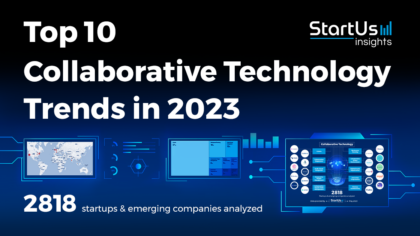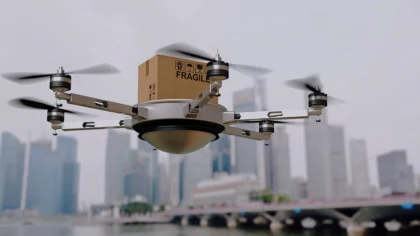Accelerate Productivity in 2025
Reignite Growth Despite the Global Slowdown
In the face of COVID-19, organizations confronted a pressing need for collaborative technologies due to workplace limitations, sparking a transformative shift in team collaboration methods. Companies began devising solutions, employing emerging technologies, and enabling teams to communicate and cooperate on projects from afar. This data-driven research unveils the leading 10 collaborative technology trends in 2023, spanning from cobots and workspace planning to collaborative diagnostics and supply chain management.
Innovation Map outlines the Top 10 Collaborative Technology Trends & 20 Promising Startups
For this in-depth research on the Top Collaborative Technology Trends & Startups, we analyzed a sample of 2818 global startups & scaleups. This data-driven research provides innovation intelligence that helps you improve strategic decision-making by giving you an overview of emerging technologies across industries. In the Collaborative Technology Innovation Map, you get a comprehensive overview of the innovation trends & startups that impact your company.
These insights are derived by working with our Big Data & Artificial Intelligence-powered StartUs Insights Discovery Platform, covering 3 790 000+ startups & scaleups globally. As the world’s largest resource for data on emerging companies, the SaaS platform enables you to identify relevant technologies and industry trends quickly & exhaustively.
Tree Map reveals the Impact of the Top 10 Collaborative Technology Trends
Based on the Collaborative Technology Innovation Map, the Tree Map below illustrates the impact of the Top Collaborative Technology Trends in 2023. Technologies, like collaborative robots, assist workers, permitting a focus on complex, strategic tasks. Workspace planning solutions prioritize workplace space optimization while audio-visual integration enhances remote meeting quality and convenience. Cooperative project management also enables team members to handle resources, schedules, and budgets in real life. Immersive telepresence, wireless conferencing, collaborative virtual environments, and digital event organization solutions improve the quality of collaborative work and offer attendees an immersive, engaging experience. Further, collaboration diagnostics yield insights for improving team efficiency. Lastly, emerging technologies in collaborative supply chain management streamline collaboration between suppliers and logistics.
Top 10 Collaborative Technology Trends in 2023
- Cobots
- Workspace Planning
- Audio Visual Integration
- Cooperative Project Management
- Immersive Telepresence
- Wireless Conferencing
- Collaborative Virtual Environment
- Digital Events Organization
- Collaboration Diagnostics
- Collaborative Supply Chain Management
Global Startup Heat Map covers 2818 Collaborative Technology Startups & Scaleups
The Global Startup Heat Map below highlights the global distribution of the 2818 exemplary startups & scaleups that we analyzed for this research. Created through the StartUs Insights Discovery Platform, the Heat Map reveals high startup activity in the US, followed by Western Europe & India. Below, you get to meet 20 out of these 2818 promising startups & scaleups as well as the solutions they develop. These collaborative technology startups are hand-picked based on criteria such as founding year, location, funding raised, & more. Depending on your specific needs, your top picks might look entirely different.
Top 10 Collaborative Technology Trends in 2023
1. Cobots
The collaborative environment is impossible to imagine without collaborative robots. Cobots work alongside humans and perform a variety of tasks across various industries. To improve the working environment and solve problems on a high level, startups develop cobots that are more affordable, easier to use, and accessible. They leverage advanced tactile sensors and human-robot interfaces, as well as incorporate machine learning algorithms. Some startups integrate immersive reality technologies to control cobots more intuitively. Others focus on materials and develop soft grippers and manipulators that handle delicate objects with a high degree of precision.
CleanBots manufactures Cleaning Cobots
Portuguese startup CleanBots offers an advanced autonomous cleaning experience through a robotic floor scrubber. It features light detection and ranging (LiDAR) sensors and depth cameras that enable it to work safely and efficiently in dynamic environments. The solution assists human workers in cleaning tasks, ensuring safety and efficiency.
Bottobo Robotics makes Collaborative Autonomous Mobile Robots (AMRs)
Turkish startup Bottobo Robotics provides collaborative AMRs for intralogistics. It utilizes a proprietary AI-based Warehouse Intelligence System. It easily integrates into warehouse management systems (WMS) or enterprise resource planning (ERP). Thus, providing various features using advanced algorithms and business analytics. The startup also utilizes 2D and 3D LiDAR, depth cameras, and IoT devices. This boosts warehouse picking operations and increases productivity without any need to change warehouse infrastructure.
Safetics builds a Cobot Cell Design
South Korean startup Safetics offers a cobot cell design tool, SafetyDesigner, for safe human-robot collaboration. It analyzes and predicts the safety of collaborative robots through simulation without physical collision experiments. The tool helps to design a cobot cell to increase productivity while ensuring safety by evaluating the power and force limit (PFL) operation.
Ally Robotics develops Robotic Arm
US-based startup Ally Robotics designs a robotic arm that increases productivity and streamlines processes in various industries. It relieves staff from repetitive tasks, serves restaurants, automates production processes, and improves the construction site’s operations. This robot can be manufactured at scale using low-cost materials and can be trained in behaviors and tasks by anyone through demonstration, similar to a human being. Thus, Ally Robotics produces an affordable, lightweight, and smart solution that works together with humans and solves real human workflow problems.
2. Workspace Planning
An organized workplace is essential for boosting collaboration and creating environments that foster productivity. To achieve this, companies implement emerging technologies to create intelligent workspaces that adapt to the changing needs of users. This involves the use of sensors, Internet of Things (IoT) devices, and AI to monitor and analyze workspace usage, identify patterns, and make real-time adjustments. To match the increasing demand, startups offer innovative solutions. For instance, they implement virtual and augmented reality (AR and VR) to create immersive workspaces to allow remote workers to take part in conversations when the office place is limited. They also improve talent management through advanced analytics to balance labor supply (skills) against demand.
SmartSuite offers a Work Management Platform
US-based startup SmartSuite provides a collaborative work management platform that enables teams to plan, track, and manage any workflow. It has a range of tools such as dashboards, records, grids, cards, kanbans, and timelines to provide real-time visibility into the progress of projects. The platform is highly customizable and offers a variety of integrations and plugins. SmartSuite helps coordinate people and work across all levels of an organization to ensure that team members have the information they need to complete their tasks effectively.
Semana develops a Connected Workspace Management Platform
French startup Semana designs a connected workspace management platform that simplifies flex-office. It helps to visualize the week, manage desk booking and meeting rooms, and connect with coworkers to collaborate. The platform shows the workspace availability and includes features such as the people matching algorithm and schedules explorer. In addition, it establishes clear hybrid work frameworks and optimizes schedule planning to empower teams. The solution brings flexibility to the workspace by eliminating the hassle of finding a space and time that works for everyone.
3. Audio Visual Integration
Emerging audio-visual integration technologies enhance audiovisual quality, reduce background noise, and optimize bandwidth usage. Other technologies such as AI and machine learning automate and streamline audiovisual processes. For instance, they introduce VR and AR technologies for boosting immersive 3D collaboration environments. AI-powered virtual assistants for video conferences also provide a high-quality call experience. These revolutionize the way employees collaborate and communicate, and are set to shape the future of the collaborative technologies industry.
QuaQua offers Real-time Interpretation
Belgian startup QuaQua adds real-time interpretation to online meeting platforms and events. This conference technology doesn’t require an additional installation and supports mobile applications. Additionally, it protects data and holds sensitive customer information that is always private and secure. QuaQua thus allows users to easily collaborate in their respective languages during online or hybrid multilingual conferences.
Audio Metaverse builds an Audio-Only Metaverse
Audio Metaverse is a UK-based startup that offers an audio-only metaverse. The startup’s app leverages spatial audio technology developed by Apple to offer an immersive soundscape. It divides the metaverse into individual sound spheres or cubes that users can own, buy, and sell. Owners of a cube are able to play music, sing, and host discussions and anyone entering specific physical spaces listens to the music. Moreover, the startup’s augmented audio reality solution reflects the position of the users in a 3D grid. It enhances the experience for listeners while enabling a novel platform for artists and creators.
4. Cooperative Project Management
Compared to the past, project management practices and technologies have evolved and become more collaborative-focused. Recently, more tools allow teams to work together in real-time and support constant communication and process management. Cloud-based technologies and platforms provide teams an opportunity to have a centralized place for project management, improving tracking, process reporting, and communication. Companies integrate AI and machine learning to optimize management processes and automate workflows, as well as for identifying bottlenecks. Startups are focusing on protecting collaborative project management data and introducing blockchain solutions. This improves project transparency, accountability, and trust.
CROOW streamlines Video Production Management
US-based startup CROOW develops an advanced platform that streamlines creative collaboration for faster and smarter video projects. It allows teams to scale video production, set up and manage video projects, and optimize storyboarding workflow in one project management platform. Moreover, it is possible to streamline the editing process and collaborate from creation to approval. This way, CROOW improves the collaboration process and communication by providing centralized access.
Wonderverse advances Web3 Collaboration
US-based startup Wonderverse designs a collaboration tooling for web3 communities. It enables project management for decentralized teams, including proposals and grant tracking. Compared to traditional project management platforms, the solution advances operations, providing a more organized workplace. In addition, the task management system includes crypto payments for contributors payment. Wonderverse thus provides a collaborative, structured, and engaging work environment for remote teams.
5. Immersive Telepresence
Effective collaboration heavily relies on communication. However, remote work often falls short of capturing the full essence of real-time interactive collaboration. To bridge this gap, immersive telepresence offers a more captivating and dynamic remote collaboration experience. Leveraging virtual reality and augmented reality, immersive telepresence solutions create virtual environments that closely emulate real-world interactions. Innovative startups are developing collaborative platforms that empower remote teams to engage in real-time discussions as well as visualize and analyze data in immersive 3D environments. Additionally, several companies are exploring the possibilities of holographic technology in collaboration with 5G and edge computing.
MyZeppi provides Immersive Remote Presence
Israeli startup MyZeppi enables immersive remote presence through physical avatars. They give the virtual participant an on-site entity to experience meaningful interactions, even remotely. Avatars enable 3D presence, have a life-size face, provide eye-level communication, and allow participants to control the view with 360-view cameras. Hence, MyZeppi improves corporate team collaboration in workshops, networking events, innovation rooms, and off-sites.
Zeeon develops 3D Employees Avatars
Ukrainian startup Zeeon designs a metaverse for professionals, where each co-worker has his own human-like avatar. This allows people to attend public speaking, networking, and co-working events remotely and communicate and act as in real life. The avatars can walk, sit, talk with voice, and send text messages. While enabling virtual offices and avatars in the metaverse, Zeeon provides collaborative and social possibilities beyond those of physical offices.

6. Wireless Conferencing
Wireless conferencing has seamlessly integrated into our daily personal and professional routines post-COVID-19. This domain continues to evolve as companies embrace emerging technologies for enhanced remote team communication and collaboration. Cloud-based conferencing platforms lead the way in wireless conferencing advancements, empowering teams to collaborate effortlessly across diverse devices and locations. Forward-thinking startups harness the potential of AI-driven voice recognition technologies, enhancing speech-to-text transcription accuracy for real-time note-taking and collaborative efforts. Additionally, they integrate noise-cancellation solutions, leveraging beamforming and echo cancellation techniques, to minimize background noise and deliver superior call quality.
VRspace.one facilitates Video Conferencing
Canadian startup VRspace.one makes a video conferencing app for unique visual and social interaction. It has an emotion detection feature, group system, and event system that allows users to host private events for more confidential or work-related discussions. The solution improves the collaboration experience by recognizing uncomfortable emotions in the workplace.
Visible offers an AI-powered Telepresence Device
Swiss startup Visible creates an AI-powered 360 degrees telepresence device for engaging meetings. It provides a continuous vision of all participants, constant eye contact, and the presence of up to 25 remote participants, which makes collaborators always see participants’ faces properly. The device has a 360 degrees display and cameras as well as uses AI for smart framing.
7. Collaborative Virtual Environment
Collaborative virtual environments provide a shared digital space where remote teams seamlessly collaborate, regardless of their physical locations. By leveraging technologies like VR and AR, such collaborative virtual environments offer an immersive and interactive experience. Team members are able to visualize and manipulate 3D models, brainstorm ideas, and engage in real-time discussions in these virtual environments. Startups and established companies, like Meta, alike are actively developing platforms that enable seamless collaboration within these virtual spaces. Through intuitive interfaces and user-friendly tools, these platforms empower teams to work together on complex projects, fostering effective communication, creativity, and innovation.
IRIS Systems creates a Government Collaboration Environment
US-based startup IRIS Systems develops GOVconnect, a project management and collaboration software that enables real-time, centralized, and secure communication across multiple departments. It provides a single cloud-based directory for all important personnel data, such as crime statistics and topographical maps, with shareable access. This allows organizations to reduce time on data searching and keep conversations centralized.
Teamind develops an Infinite Online Whiteboard
Chinese startup Teamind provides an infinite online whiteboard that fosters real-time collaboration. It has a built-in video conferencing and chat system that enables team members to communicate in real time. In addition, the whiteboard provides real-time data and analytics on team performance, enabling managers to identify bottlenecks and areas for improvement. The solution allows meeting participants to work on the same document and edit at the same time, allowing more efficient communication.
8. Digital Events Organization
The rapid growth of remote work and the COVID-19 pandemic requires organizations to adapt to a new way of hosting events and engaging with their audience. Therefore, traditional in-person events have been replaced by virtual and hybrid events, which require new technologies and tools to ensure a seamless and interactive experience for attendees. To fill this gap, startups innovate in the digital events space, with a focus on providing collaborative and immersive technologies that replicate the benefits of in-person events. To engage with the audience, event platforms enable organizers to host interactive virtual events with features such as live polling, Q&A sessions, and gamification. Blockchain also creates secure and transparent ticketing and payment systems for digital events.
Kumospace provides Virtual Office Space
US-based startup Kumospace creates a go-to virtual office for remote teams to collaborate and build culture. It allows employees to move around the virtual office and connect with spatial audio. Other features include multiple screen sharing, recording for team communication, online whiteboards, digital games, and customizable spaces. The online workspace also offers people analytics and shows how the team spends the time with virtual office platform. The solution helps remote teams build company culture and connection regardless of geography.
pragatiE offers a Virtual Exhibitions Platform
Indian startup pragatiE makes an intelligent virtual exhibitions platform. The smart platform provides engaging live sessions through which participants communicate during the event in real-time. It provides an opportunity to meet and greet visitors virtually and generate leads like real events. Features such as chat boxes, targeted contests, and virtual meetings make the audience feel welcomed and at home. The solution enables companies to host all events, product launches, exhibitions, showcases, and conferences virtually.
9. Collaboration Diagnostics
Collaborative diagnostics is an emerging field that leverages technology to enable faster and more accurate disease diagnoses. Such technologies transform the healthcare industry by leveraging AI, machine learning, and cloud computing to enable remote collaboration and data sharing between medical professionals. AR systems allow specialists to remotely guide local physicians through complex procedures, enabling faster and more accurate diagnoses. Healthcare institutions also deploy machine learning and computer vision to improve the accuracy of real-time collaborative cancer diagnoses.
Collaborate Healthcare aids Patient Customer Relationship Management (CRM)
Greek startup Collaborate Healthcare develops a patient CRM and collaboration tool. It provides medical information in a way that decreases the cognitive burden and distraction and highlights key data to ensure it is not overlooked. Its team-based diagnosis feature facilitates secured team-based diagnostic reasoning and helps colleagues to discuss challenging cases online through a chat. This helps doctors avoid errors and increase patient compliance by facilitating diagnostic and communication tasks, particularly those related to team-based diagnosis and patient follow-up.
10. Collaborative Supply Chain Management
The emerging collaborative technologies allow enterprises to optimize supply chain operations and have real-time collaboration and data sharing from locations with different time zones. Startups use IoT, cloud computing, and continuous service management software to track goods in transit and provide real-time data to all stakeholders, enabling collaboration and data-driven decision-making. Other solutions include goods in transit tracking and inventory monitoring to optimize freight transportation, helping businesses reduce costs and improve delivery times.
Adabt develops a Logistics Collaboration Platform
Dutch startup Adabt designs an integration platform for automating data exchange and communication between shippers, carriers, and trading partners. This integration automates order processing through manual operations elimination. The platform strengthens data and service quality by centralizing data for stakeholders and informing partners with real-time information. The startup’s data-driven collaboration platform enables businesses to streamline order entry and communication with customers and to deal with valuable data in a structured manner.
Discover all Collaborative Technology Trends, Technologies & Startups
The landscape of collaborative technologies perpetually evolves, with startups continually fostering engaging, productive experiences for remote and distributed teams. VR and AR empower employees to interact as though they share a room while AI aids decision-making. Natural language processing (NLP) and translation further simplify collaboration across different regions and languages. The Collaborative Technology Trends & Startups outlined in this report only scratch the surface of trends that we identified during our data-driven innovation & startup scouting process. Identifying new opportunities & emerging technologies to implement into your business goes a long way in gaining a competitive advantage.





![Future of Robotics: 12 Trends Powering the Next Wave [2025-2030]](https://www.startus-insights.com/wp-content/uploads/2025/06/Future-of-Robotics-SharedImg-StartUs-Insights-noresize-420x236.webp)





